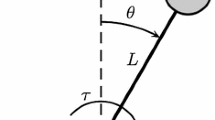Abstract
Linguistic dynamic systems (LDS) are the systems based on computing with words (CW) instead of computing with numbers or symbols. In this paper, LDS are divided into two types: type-I LDS being converted from conventional dynamical systems (CDS) by using extension principle and type-II LDS by using fuzzy logic rules. For type-I LDS, the method of endograph is provided to discuss the stabilities of type-I LDS and two cases of stabilities of logistic mappings: one is the states being abstracted and the other is parameters also being abstracted. For type-II LDS, the method of degree of match is used to discuss the dynamical behavior of arbitrary initial words under fuzzy rule.
Similar content being viewed by others
References
Zeng F P, Mo H, Guo W J. ω-Limit set of a tree map. Northeast Math J, 2001, 17(3): 333–339
Block L, Coppel W A. Dynamics in one-dimension. Lecture Notes in Math, 1513. Berlin: Springer, 1991
Mo H, Shi S Q, Zeng F P, et al. An arc as the inverse limit of a single bonding map of type N on [0,1]. Acta Math Sin, 2005, 20(5): 925–932
Zadeh L A. Fuzzy sets. Inf Contr, 1965, 12: 38–353
Kosko B. Neural Network and Fuzzy Systems: A Dynamical System Approach to Machine Intelligence. Englewood Cliffs, NJ: Prentice Hall, 1992
Hsu C S. Cell-to-Cell Mapping. New York: Springer-Verlag 1987
Hsu C S. A generalized theory of cell-to-cell mapping for nonlinear dynamical systems. ASME J Appl Mech, 1981, 48: 634–842
Zadeh L A. Fuzzy Sets, Language Variable and Fuzzy Logic (in Chinese). Beijing: Science Press, 1982
Wang F Y. Computing with words and the framework for computational linguistic dynamical systems (in Chinese). Patt Recog Intell Contr, 2001, 14(4): 377–384
Wang F Y. Modeling, analysis, and synthesis of linguistic dynamic system: a computational theory. In: Proc. of IEEE International Workshop on Architecture for Semiotic Modeling and Situation Control in Large Complex System. Monterey, CA, August, 27–30, 1995. 173–178
Wang F Y. Outline of a computational theory for linguistic dynamic systems: Toward computing with words. Int J Intell Control Syst, 1998. 2(2): 211–224
Wang F Y, Yang T, Mo H. On fixed points of linguistic dynamic systems. J Syst Simul, 2002, 14(11): 1479–1485
Cabrelli C A, Forte B, Molter U M, Vrscay E R. Iterated fuzzy set systems: A new approach to the inverse problem for fractals and other sets. J Math Anal Appl, 1992, 171(1): 79–100
Roman-Flores H, Barros L C, Bassanezi R C. A note on Zadeh’s extension. Fuzzy Sets Syst, 2001, 117(3): 327–331
Zadeh L A. Fuzzy logic=Computing with words. IEEE Trans Fuzzy Syst, 1996, 4(2): 103–111
Layne J R, Passino K M. Lyapunov stability analysis of fuzzy dynamic systems. In: Fuzzy Control: Synthesis and Analysis. New York: John Wiley and Sons, 2000. 95–111
Thathachar L, Viswanath P. On the stability of fuzzy systems. IEEE Trans Fuzzy Syst, 1997, l5(1): 145–151
Cheng S W. Complex science and management (in Chinese). Bull Chinese Academy Sci, 1999, (3): 175–183
Yang X G, Ma C Q. Complex of the financial system (in Chinese). Syst Eng, 2003, 21(5): 1–4
Peter E E. Chaos and Order in the Capital Market. 2nd ed. New York: Wiley, 1996
Hesich D. Chaos and nonlinear dynamics: application to financial markets. J Finance, 1991, 46: 1839–1877
Wu C F, Feng Y. The system thinking for the global volatility and contagion (in Chinese). J Manag Sci China, 1999, 2(1): 7–15
Cheng S W. Fictitious economy and financial crisis (in Chinese). J Manag Sci China, 1999, 2(1): 1–6
Samuelson P A, Nordhaus W D. Macroeconomics (in Chinese). Translated by Xiao Sm et al. Beijing: Hua Xia Publishing House, 1999
Robandi I, Kharisma B. Design of interval type-2 fuzzy logic based power system stabilizer. Proc World Academy Sci Eng Tech, 2008, 31: 683–690
Singh M, Srivastava S, Hanmandlu M. et al. Type-2 fuzzy sets based modeling of nonlinear system using choquet integral and fuzzy difference equation. Int J Comput Cognit, 2008, 6(1): 1–7
Author information
Authors and Affiliations
Corresponding author
Additional information
Supported by the National Natural Science Foundation of China (Grant Nos. 60125310, 60474498)
Rights and permissions
About this article
Cite this article
Mo, H., Wang, F. Linguistic dynamic systems based on computing with words and their stabilities. Sci. China Ser. F-Inf. Sci. 52, 780–796 (2009). https://doi.org/10.1007/s11432-009-0089-6
Received:
Accepted:
Published:
Issue Date:
DOI: https://doi.org/10.1007/s11432-009-0089-6




